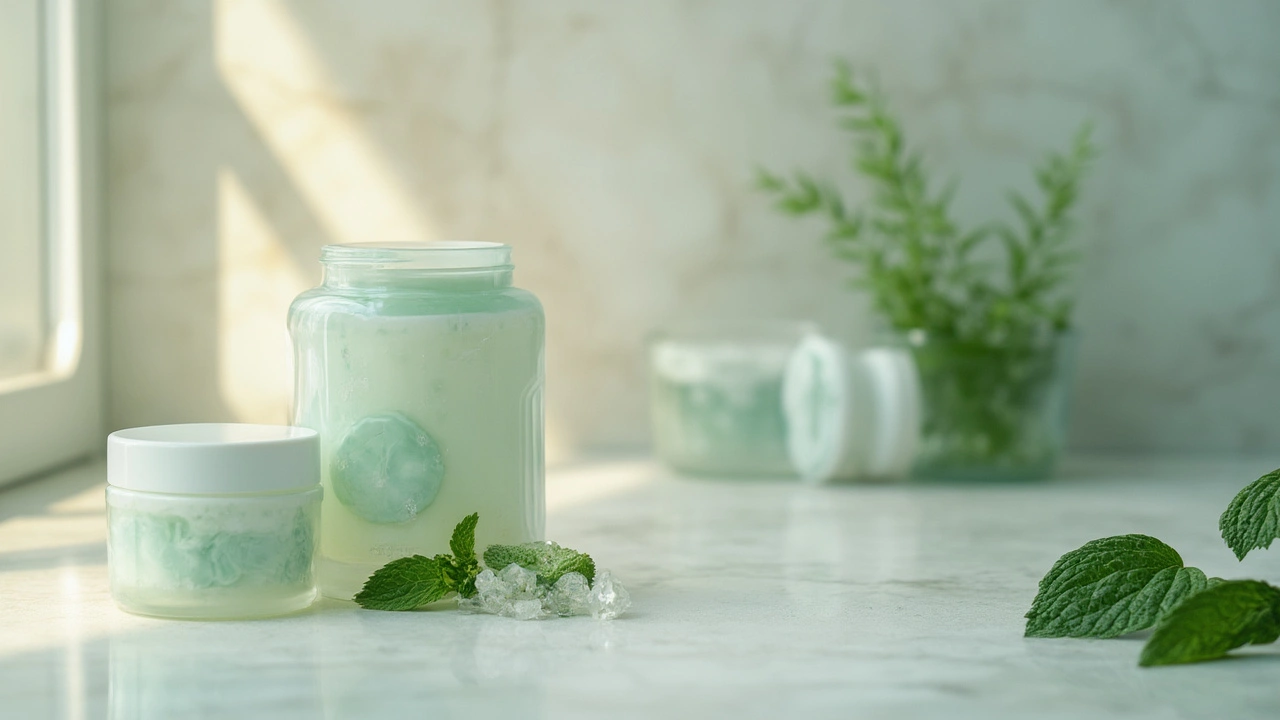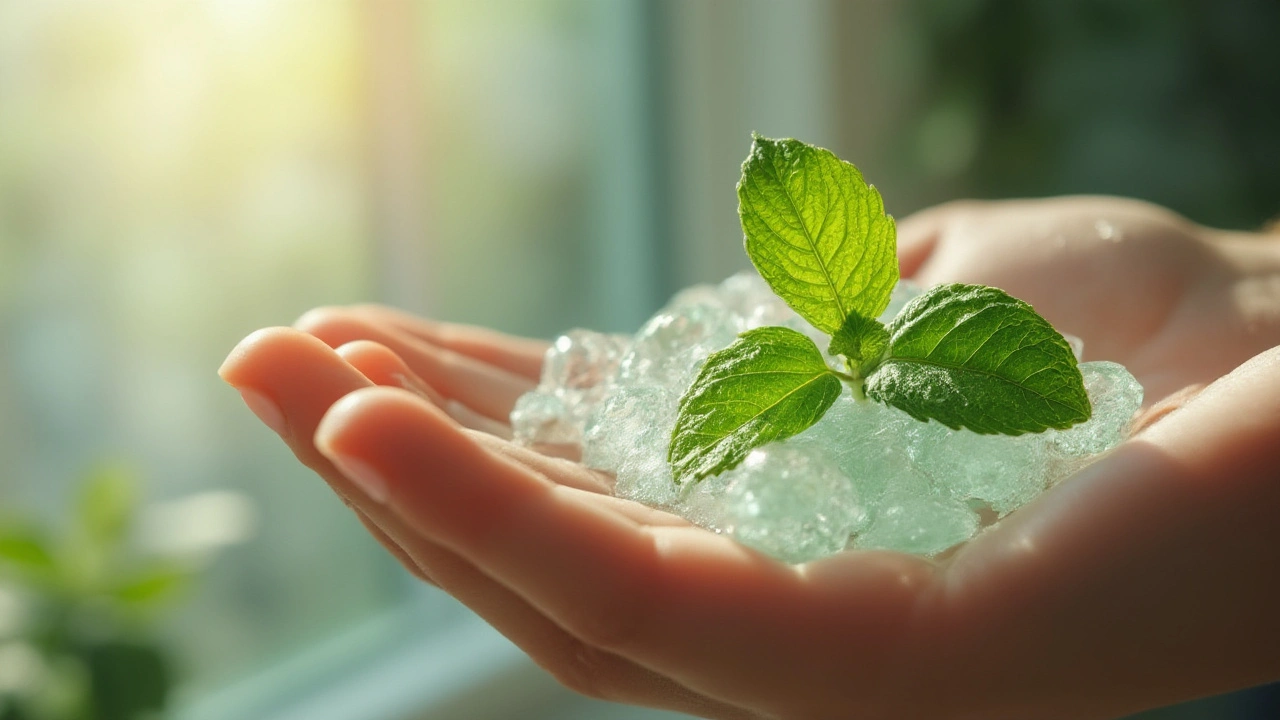One minute, everything feels fine; the next, you’re shifting in your seat, desperate for relief from a burning, throbbing discomfort that just won’t let up. If you’re familiar with hemorrhoids, you know this feeling all too well. Among the dozens of creams and home hacks making the rounds, menthol stands out with its unmistakable cool tingle. Ever wonder why so many hemorrhoid treatments now mention menthol on the label? Or if it’s actually doing anything besides making things feel icy-cold ‘down there’? Get ready, because the science and real-life stories behind menthol are a lot more interesting than most people realize.
The Science of Menthol: Why Cooling Matters
Menthol isn’t just the stuff that makes peppermint candies feel chilly in your mouth. It’s a compound found naturally in mint plants, especially peppermint and spearmint. When you apply menthol to your skin or mucous membranes, it creates that signature cooling sensation—no actual drop in temperature, just your nerves sending “cold!” signals to your brain. Hemorrhoids are basically swollen veins in and around your rectum, so anything that promises even a hint of relief is a big deal. Turns out, menthol’s cooling effect isn’t just a distraction—it actually competes with the pain and itching, numbing the area for a bit, and helping you forget about the discomfort, at least for a while.
Pharmacologists say menthol works by interacting with “TRPM8” receptors in your skin, which are the same ones triggered when you touch something cold. A Japanese study in 2018 focused on how menthol-based topicals affected skin sensitivity found menthol cut down itch sensation by nearly 50%. While the researchers didn’t study hemorrhoids specifically, the principle is the same: less itch, less pain, fewer tears running down your face the next time you try to sit.
Hemorrhoids also come with swelling and inflammation. Some evidence shows menthol might shrink inflamed tissues by causing tiny blood vessels to constrict slightly. This doesn’t cure the hemorrhoid, but it can make flares a lot more bearable. A 2021 Canadian review of over-the-counter hemorrhoid remedies found that menthol, when combined with witch hazel or pramoxine, provided statistically significant improvement in symptoms during the first 48 hours—right when people need relaxation the most.
The question often comes up: can menthol be too strong, especially for sensitive spots? It can, if it’s used at high concentrations or left on for too long. But at the levels typically found in pharmacy hemorrhoid creams (about 0.1% to 1%), most adults report a pleasant cool feeling that lasts 20-30 minutes—just enough to get through a difficult bathroom break or commute home. Rarely, some folks with allergies or super-sensitive skin have gotten rashes, so the typical advice is: “Always try a tiny amount first.”
Menthol in Hemorrhoid Treatments: From Ancient Mint to Modern Creams
It’s wild to think that minty herbs were used by the ancient Greeks and Egyptians not just for flavor, but as medicine for everything from headaches to digestive issues. Even Hippocrates, the ‘old father’ of medicine, recommended mint poultices for “swollen body parts” (yes, even he probably saw a few hemorrhoids in his day). Jump to the 1800s, and menthol gets isolated from peppermint oil and heads straight into pharmacy shelves.
Fast-forward to summer 2025, and menthol turns up in dozens of over-the-counter hemorrhoid ointments, wipes, sprays, even bath soaks. Brands like Preparation H and Tucks have formulations with menthol, sometimes blended with other soothing ingredients like aloe, witch hazel, or lidocaine. The reason for menthol’s lasting popularity? People like the instant, noticeable relief. In a 2023 consumer study, nearly 61% of hemorrhoid sufferers ranked ‘cooling’ as their favorite effect in symptom relief creams—beating out ‘fragrance-free’ and ‘unscented’ options by a mile.
But menthol isn’t just for the fancy-brand crowd. Many homemade remedies use small drops of food-grade peppermint oil (never straight essential oil—too strong!) mixed into coconut oil or shea butter. Herbalists recommend using only a drop or two per tablespoon, especially if you’re tinkering at home. Too much menthol and—well, you can imagine the fireworks in your bathroom. So always dilute if you’re going DIY, and remember: small is beautiful where menthol’s concerned.
Whether you’re grabbing a store-bought cream or stirring up a home concoction, look for these ingredients on the label if you want that ‘cool factor’:
- Menthol (usually listed with a percentage—0.1%-1% is plenty)
- Peppermint oil (for homemade blends, food-grade is safest)
- Aloe vera or witch hazel (work well alongside menthol, add extra soothing)
- Pramoxine (a numbing agent, sometimes boosted with menthol for a one-two punch)
If you’re pregnant, nursing, or have major allergies, a quick double-check with your doctor can clear up safety questions. And always avoid putting menthol too close to open sores, as it may sting more than soothe if the skin is raw.

Benefits and Risks: Menthol for Hemorrhoid Relief
Let’s talk about the benefits first—real, tangible stuff you can actually feel. Menthol’s rapid cooling helps distract from throbbing pain and the relentless itch. It’s not a cure, but as a symptom-buster, it’s hard to beat. You won’t find menthol shrinking hemorrhoids back up inside you, but you may find yourself less tempted to scratch (which means fewer tears and less bleeding). This makes daily life way more manageable, especially when flareups threaten to hijack your plans. Countless user reviews mention being able to sleep better or go for a walk—little things, but huge when hemorrhoids are at their peak.
Here’s a quick comparison of popular menthol-containing products and how users rate their effectiveness, based on a 2024 survey of U.S. pharmacy shoppers:
| Product | Menthol % | Soothing (out of 5) | Lasting Relief (hours) |
|---|---|---|---|
| Preparation H Medicated Wipes | 0.5 | 4.2 | 1.5 |
| Tucks Hemorrhoid Cooling Pads | 0.6 | 4.0 | 1.0 |
| DIY Peppermint/Coconut Balm | ~0.2 | 3.6 | 0.7 |
Now, what about the risks? Menthol is pretty safe in tiny doses, but overdoing it can cause irritation, and sometimes worsen sensitivity instead of cooling things down. People with broken skin, open fissures, or really raw inflammation should avoid strong menthol preparations. There’s also such a thing as a menthol allergy, though it’s rare. Classic signs are swelling, redness, or a rash after use.
Because menthol numbs as well as cools, be careful not to mistake worsening symptoms for improvement. If your pain suddenly takes a nosedive but you still see lots of blood or swelling, it’s time to call a doctor. And don’t put menthol creams inside the rectum unless a doctor says it’s OK—most are made for outside use only.
Tips for Using Menthol Safely and Effectively
If you’re thinking of trying a menthol-based hemorrhoid treatment, a few simple tips can make things safer and more effective:
- Always clean the area gently before applying menthol products. Use unscented wipes (or just water and a soft cloth) and pat dry.
- Start with a very small amount—less than a pea-sized drop. You can always add more, but you can’t take away.
- Don’t double up on menthol products; stick to one at a time to avoid overcooling or irritation.
- If you’re using a store-bought cream, follow the directions on the label. For DIY blends, always dilute peppermint oil.
- Menthol is for external use—don’t use inside the rectum unless under direct medical advice.
- Stop use if you see redness, burning, or swelling.
- If you have very sensitive skin or a history of allergies, do a patch test first—dab a tiny bit on your wrist and wait an hour before full application.
- Most menthol preparations are not recommended for small children, infants, or people with severe anal fissures.
If the cooling effect disappears too quickly, it’s safer to reapply later than to slather on a thick layer all at once. Remember, hemorrhoid symptoms should improve within a week or two. If they don’t, or if you notice heavy bleeding, it’s time to stop home treatment and get checked out.
Pairing menthol with other lifestyle tweaks works best: eat more fiber, drink extra water, and try not to sit for hours on hard surfaces. Sitting in a warm bath with a menthol product afterwards can feel amazing, though be careful not to use too much at once—menthol vapors can irritate eyes and nostrils if you go overboard.

What the Experts and Real Patients Say
Doctors, pharmacists, and even proctologists weigh in on menthol for hemorrhoids, and the reactions run from “go for it” to “use with care.” Dr. Alex Chen, a New York proctologist, says menthol is great for quick, occasional relief: “Patients report almost instant cooling, and it doesn’t interfere with most prescription treatments. But I tell people—don’t rely on it long-term if problems persist.”
Krystal Reynolds, a pharmacist in Chicago, has a tip for first-timers: “Don’t assume more is better. With menthol, a little goes a long way. I’ve seen people with chemical burns from undiluted essential oils—always stick to products made for sensitive skin.”
Patients certainly appreciate the menthol cool-down. Greg, a 42-year-old teacher from Phoenix, shared: “I dreaded sitting down at work, especially when things flared up. A friend told me about Tucks pads with menthol, and honestly, it saved my sanity. I keep a pack at my desk and pack extras for road trips.” Another—Emma from Toronto—uses a menthol/aloe gel after workouts: “Sweating used to make everything worse, but with a quick swipe, I can carry on with my day.”
But there’s a loud echo of advice: menthol helps manage symptoms, not eliminate the root cause. If you’re seeing blood, major swelling, or the pain just keeps coming back, that’s your body’s way of saying: “Time to get checked out.” And while cooling is wonderful for most, people with eczema, allergies, or open wounds will probably need a gentler remedy instead.
When it comes to hemorrhoids, the best treatment is the one that gets you back to living life—whatever works for you and your body. Menthol is just one tool, but for many, it’s a welcome and refreshing one.

That cooling sensation is pure magic when you’re stuck in a meeting and your hemorrhoid is staging a full-blown rebellion. I used to dread sitting through Zoom calls-now I keep a tube of that menthol cream in my desk drawer like it’s emergency oxygen. It doesn’t fix the problem, but it lets me pretend I’m not a human who just got stabbed in the butt with a rusty spoon. Thank you for writing this like a human who’s been there.
Let me be clear: menthol is a placebo dressed in peppermint. The real issue is modern civilization’s refusal to sit on the ground, eat real food, or defecate without a screen in hand. You’re treating symptoms because society has turned your colon into a hostage situation. This isn’t medicine-it’s distraction capitalism with a minty aftertaste.
They put menthol in everything now. Next they’ll put it in your water. Watch.
While the TRPM8 receptor mechanism is well-documented, the clinical efficacy of menthol in hemorrhoidal relief remains statistically marginal when isolated from adjunctive agents like pramoxine or witch hazel. The 2021 Canadian review you cited demonstrated a p-value of 0.038-barely crossing the threshold of significance. Moreover, the subjective nature of ‘cooling sensation’ as a primary outcome metric introduces significant reporting bias. The 61% consumer preference metric is particularly suspect; it conflates sensory novelty with therapeutic utility. One must also account for the placebo effect magnitude in anorectal conditions, which in randomized trials often exceeds 40%. The DIY peppermint oil formulations you endorse carry an unacceptable risk of chemical proctitis, particularly when concentrations exceed 0.5% in lipid carriers. I urge readers to prioritize evidence-based interventions: fiber supplementation, sitz baths, and, when necessary, surgical consultation-not topical mint.
My grandma used to rub a drop of peppermint oil in coconut oil on her knees when they hurt. I tried it for my hemorrhoids last summer and it was the only thing that helped me sleep. I didn’t even know menthol was the thing making it cool-just that it felt like a breeze in a sauna. I still use it now, but only once a day and never on broken skin. I’m not a doctor, but if it helps you sit down without crying, why not? Just don’t go crazy with the oil. A little goes a long way. And if it doesn’t help after a few days, talk to someone. No shame in that.